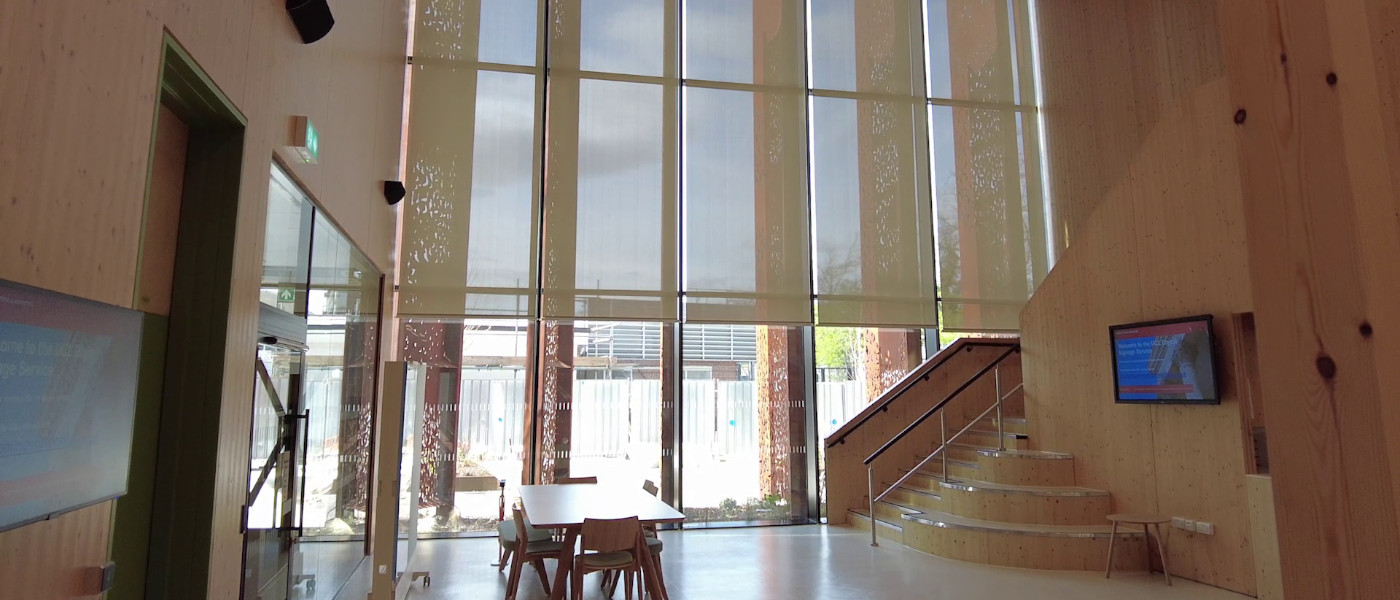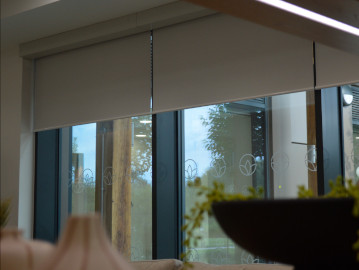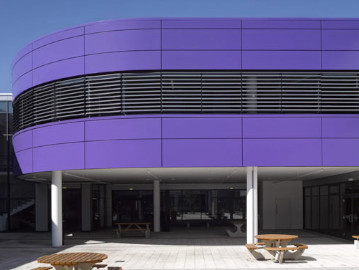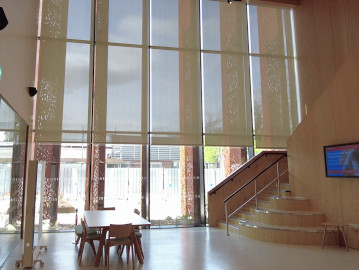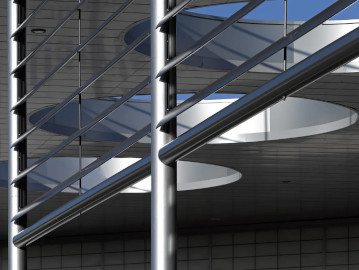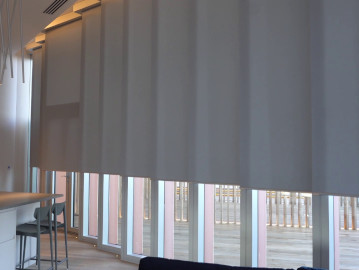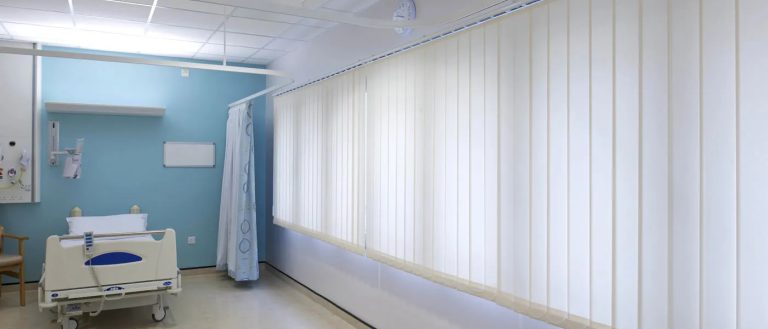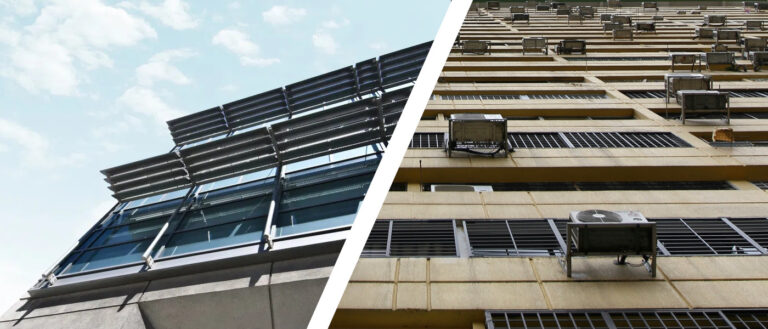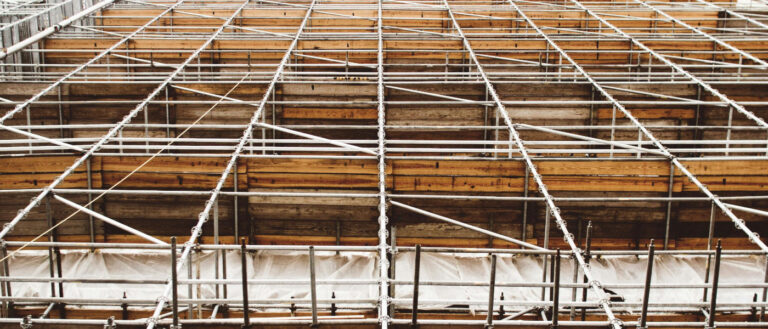11 Ways to Improve Your BREEAM Score with Solar Shading
If you’re looking to enhance your building’s environmental performance, then aiming for a higher BREEAM score should be high on your list of priorities.
The BREEAM rating system is a renowned global standard that assesses various aspects of sustainability in buildings.
But have you considered how solar shading could significantly improve your BREEAM score?
Before diving into the specifics, let’s break down what BREEAM evaluates and why it’s so important.
What BREEAM Evaluates
The BREEAM (Building Research Establishment Environmental Assessment Method) rating system assesses a wide range of sustainability aspects in buildings.
Here’s a closer look at the key categories:
Energy
BREEAM evaluates how well a building conserves energy, promotes energy efficiency, and incorporates renewable energy sources.
This includes everything from the building’s insulation and glazing to its heating, ventilation, and air conditioning (HVAC) systems.
Water
This category assesses the building’s water usage efficiency, the presence of water-saving fixtures, and effective water recycling and harvesting systems.
It aims to reduce the building’s water footprint and ensure sustainable water use.
Waste
BREEAM looks at how waste is minimised, reused, and recycled during both construction and operation.
Effective waste management strategies contribute significantly to a building’s overall sustainability.
Pollution
BREEAM evaluates the measures taken to reduce air, water, and land pollution.
This includes assessing the impact of the building’s emissions, the management of refrigerants, and strategies to reduce noise and light pollution.
Transport
BREEAM considers the accessibility of the building to public transport, the availability of cycling facilities, and measures to encourage sustainable travel options.
This category aims to reduce the environmental impact of transportation associated with the building.
Materials
BREEAM assesses the sourcing, durability, and environmental impact of the materials used.
It encourages the use of sustainable, low-impact materials and considers the whole lifecycle of these materials.
Health and Wellbeing
This category evaluates factors such as indoor air quality, lighting, thermal comfort, and acoustic performance.
Ensuring a healthy and comfortable environment is crucial for occupant satisfaction and productivity.
Management
Effective management practices are essential for achieving sustainability goals. BREEAM assesses the management processes during the design, construction, and operational phases.
This includes considering how sustainability objectives are set, monitored, and achieved.
Land Use and Ecology
The impact of the building on its surrounding environment is critical.
BREEAM looks at how well the building preserves and enhances local ecology, the sustainable use of land, and measures to protect and enhance biodiversity.
Innovation
Innovation credits are awarded for pioneering sustainable practices and technologies.
This category encourages buildings to go beyond standard practices and incorporate innovative solutions that significantly improve sustainability.

How Solar Shading Contributes to BREEAM Certification
Now that we’ve broken down the core components of BREEAM, let’s explore how solar shading can help you achieve higher scores across these categories.
Solar shading isn’t just about managing sunlight; it plays a crucial role in enhancing a building’s overall sustainability.
Whether it’s through improving energy efficiency or enhancing occupant well-being, the right solar shading solutions can make a substantial difference.
Here are eleven effective ways to leverage solar shading for a better BREEAM score.
Enhancing Health and Wellbeing
1. Glare Control
Solar shading solutions are excellent for controlling glare from sunlight.
Too much glare can be a significant problem, leading to discomfort and reduced productivity. By implementing effective shading, you create a more comfortable environment for everyone in the building.
2. Daylight Utilisation
Well-designed shading systems allow you to maximise natural daylight without the associated discomfort.
This not only enhances occupant well-being but also reduces the need for artificial lighting, which in turn improves energy efficiency.
Boosting Energy Efficiency
3. Thermal Comfort
One of the standout benefits of solar shading is its ability to reduce heat gain from the sun. This can significantly lower the cooling loads in your building, reducing the need for air conditioning.
Not only does this contribute to a more energy-efficient building, but it also helps in lowering your carbon emissions.
4. Energy Performance
Improving the performance of your building’s envelope through shading can result in higher BREEAM scores in energy performance assessments.
The reduction in energy use due to efficient shading means less strain on your HVAC systems and lower operational costs.
Using Sustainable Materials
5. Durable and Recyclable Materials
Opting for shading solutions made from durable and recyclable materials can positively impact the materials category in BREEAM.
By minimising the environmental impact throughout the lifecycle of these materials, you contribute to a more sustainable building.
6. Lifecycle Assessment
Materials with a low environmental impact can improve your BREEAM scores under lifecycle assessment criteria.
By choosing sustainable shading solutions, you demonstrate a commitment to reducing the overall environmental footprint of your project.
7. Waste Management
Effective solar shading solutions can play a role in waste management strategies. During construction and operation, focusing on minimising waste production is crucial.
Implementing shading systems that encourage reuse and recycling supports circular economy principles and helps in reducing landfill use.
Reducing Night-time Light Pollution
8. Light Pollution Control
Solar shading isn’t just about managing sunlight during the day. These solutions can also help control light pollution at night by reducing unnecessary light spillage.
This is especially important for buildings in urban areas where light pollution can be a significant issue.
9. Compliance with Regulations
Proper shading ensures your building complies with local light pollution regulations, which can contribute to higher BREEAM scores.
Meeting these standards not only improves your rating but also supports the surrounding community.
Implementing Innovative Designs and Smart Integration
10. Innovative Shading Solutions
Embracing advanced and innovative shading systems can earn you additional credits under the innovation category.
These solutions often push the boundaries of sustainable building design and operation, showcasing your commitment to cutting-edge environmental practices.
11. Smart Integration
Integrating shading solutions with building management systems (BMS) for automated control is a smart move.
This approach can be considered innovative and contribute to your BREEAM credits by ensuring optimal performance and energy efficiency.
Key Aspects of Solar Shading
To achieve the best results, consider these key aspects of solar shading:
- Glare Control: Manage and reduce direct sunlight glare for a comfortable visual environment.
- Daylight Utilisation: Maximise natural light while reducing reliance on artificial lighting.
- Maintaining Views: Maintain clear views to the outside while providing necessary shade.
- Flexible Solutions: Adjustable systems allow customised control of light and heat.
- Thermal Comfort: Reduce heat gain to maintain stable indoor temperatures.
- Privacy Control: Provide privacy without compromising natural light and views.
- Aesthetic Integration: Enhance the building’s aesthetic appeal with customisable shading designs.
Energy Savings
By reducing the need for artificial lighting and air conditioning, solar shading contributes to significant energy savings, leading to lower operational costs.
Durability and Maintenance
Modern shading solutions are designed for durability and low maintenance, ensuring long-term performance and sustainability.
Environmental Impact
Solar shading systems made from sustainable materials further reduce the environmental footprint of your building project.
Choosing the Right Shading Solutions
Selecting the appropriate shading solutions is crucial for optimising your BREEAM score:
- Blinds: Adjustable and effective for controlling light and glare.
- Fixed Shading (e.g., Brise Soleil): Permanent solutions that block direct sunlight and reduce heat gain.
- Window Film: Reduces glare and heat gain while maintaining views and natural light.
- Motorised Shading Systems: Provide flexibility and convenience in controlling light and heat.
- External Louvres: Offer excellent control over sunlight and heat gain while adding a dynamic architectural element.
- Dynamic Shading Systems: Adjust in real-time based on environmental conditions and occupancy.
| Shading Type | Pros | Cons | Best For |
|---|---|---|---|
| Blinds | Adjustable, cost-effective | May require manual operation | Offices, residential |
| Fixed Shading (e.g., Brise Soleil) | Low maintenance, architectural appeal | Not adjustable | Hot seasons, south-facing facades |
| Window Film | Maintains views, easy installation | Less effective than physical shading | Retrofits, budget-conscious projects |
| Motorised Shading Systems | Convenient, precise control | Higher initial cost | High-end commercial, smart homes |
| External Louvres | Excellent heat control, aesthetic appeal | More complex installation | Modern office buildings, schools |
| Dynamic Shading Systems | Optimal performance, energy-efficient | Highest initial cost | Large commercial projects, eco-focused designs |
Implementation Best Practices for Optimal Results
To ensure you get the best out of your solar shading solutions, follow these best practices:
- Early Integration: Incorporate solar shading strategies early in the design process.
- Climate-Specific Design: Select shading solutions based on local climate conditions.
- Orientation-Based Approach: Tailor shading strategies to different building facades.
- User Control: Allow occupants some level of control over shading to enhance satisfaction.
- Regular Maintenance: Establish a maintenance schedule to ensure long-term performance.
- Performance Monitoring: Implement systems to track the effectiveness of shading solutions over time.
Proper implementation of solar shading not only improves building performance but also enhances occupant well-being and productivity.
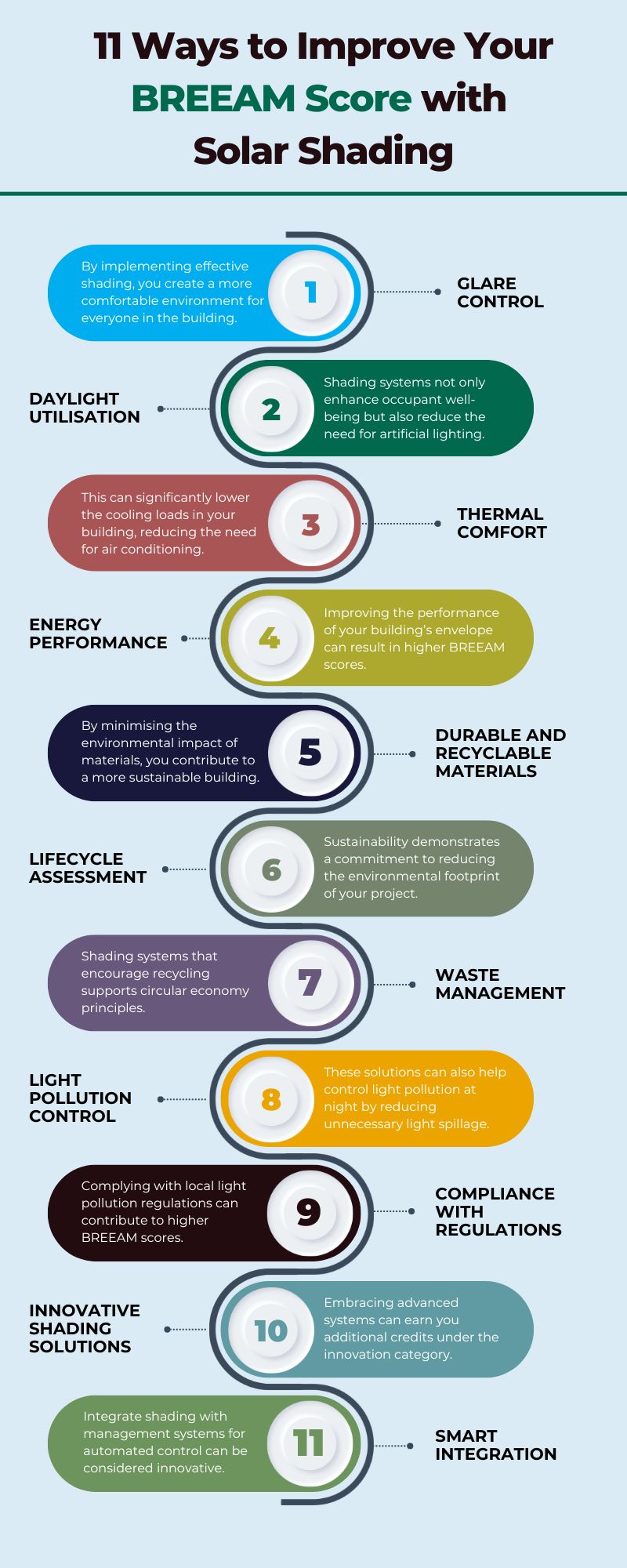
Conclusion
Remember, solar shading is just one aspect of a comprehensive sustainable building strategy.
It should be considered alongside efficient HVAC systems, renewable energy sources and sustainable materials to achieve the best possible BREEAM ratings.
By paying attention to these details, you can create a building that is not only environmentally friendly but also economically viable and comfortable for its occupants.
Our team is here to help you select the right solar shading that will transform your project into an efficient and performant space.
Frequently Asked Questions (FAQ)
How does solar shading improve energy efficiency in buildings?
Solar shading helps improve energy efficiency by reducing the amount of heat that enters a building. By blocking or filtering direct sunlight, shading systems can significantly lower cooling loads, reducing the need for air conditioning.
This leads to lower energy consumption, reduced carbon emissions, and lower operational costs. Additionally, effective shading can optimise natural daylight utilisation, reducing the dependence on artificial lighting and further conserving energy.
What types of solar shading solutions are most effective for BREEAM certification?
Several solar shading solutions can enhance BREEAM certification, including:
- Blinds: Adjustable blinds offer precise control over light and glare, improving visual comfort and energy efficiency.
- Fixed Shading (e.g., Brise Soleil): Permanent fixtures that block direct sunlight, reducing heat gain without obstructing views.
- Window Film: A cost-effective solution that reduces glare and heat gain while maintaining visibility and natural light.
- Motorised Shading Systems: Automated systems that adapt to changing environmental conditions, offering optimal performance and user convenience.
- External Louvres: These provide excellent control over sunlight and heat gain, enhancing both energy efficiency and the building’s aesthetic appeal.
- Dynamic Shading Systems: Advanced systems that adjust in real-time based on environmental conditions and occupancy, ensuring optimal comfort and energy savings.
How can solar shading contribute to the health and well-being of building occupants?
Solar shading enhances the health and well-being of occupants by controlling glare and maximising natural daylight. By reducing glare, shading systems prevent discomfort and eye strain, creating a more comfortable visual environment.
Effective shading also ensures that natural light is utilised without causing excessive heat or discomfort, promoting a pleasant and productive atmosphere. Furthermore, by maintaining stable indoor temperatures, shading contributes to thermal comfort, which is essential for overall well-being.
What are the best practices for implementing solar shading to maximise BREEAM scores?
To maximise BREEAM scores with solar shading, consider the following best practices:
- Early Integration: Incorporate shading strategies early in the design process to ensure they are optimally integrated with other building systems.
- Climate-Specific Design: Choose shading solutions tailored to the local climate to address specific sunlight and heat gain challenges.
- Orientation-Based Approach: Customise shading strategies for different building facades based on their sun exposure and orientation.
- User Control: Provide occupants with some level of control over shading systems to enhance their comfort and satisfaction.
- Regular Maintenance: Establish a maintenance schedule to ensure the long-term performance and effectiveness of shading solutions.
- Performance Monitoring: Implement systems to track the effectiveness of shading solutions over time and make adjustments as needed to maintain optimal performance.
For enquiries about our solar shading solutions:
Enviroscreen Systems
Swift House,
13 Ronsons Way,
St Albans,
AL4 9QT
United Kingdom
Telephone: 01727 220 007
E-mail: info@enviroscreen.org.uk

